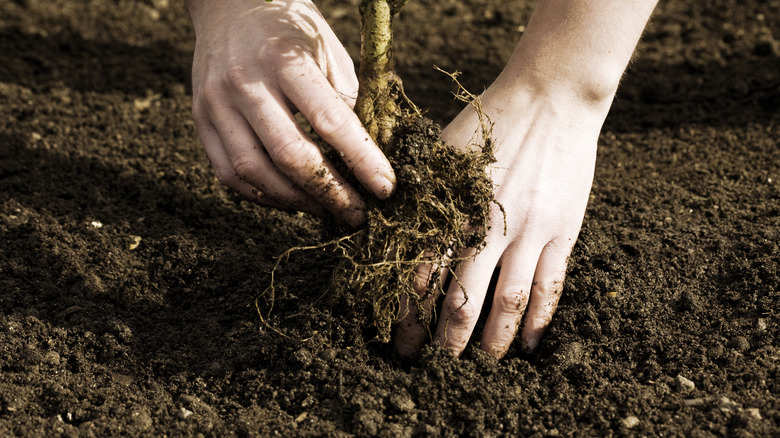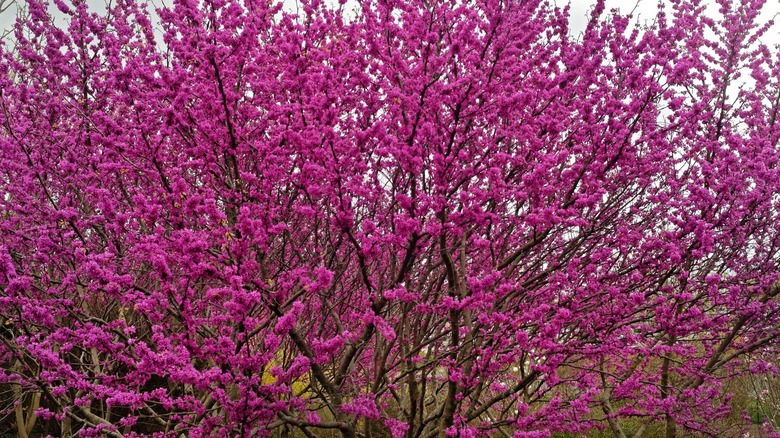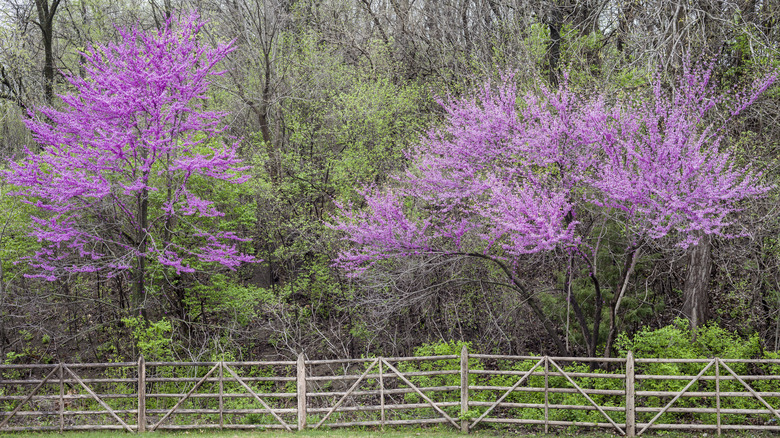This Vibrant Tree Will Bring Stunning Color To Your Spring Landscape
After a long and dreary winter, it's always exciting to see the first flashes of spring color pop up on the landscape. Whether it's a sunny daffodil or mysterious crocus, by March we are more than ready for a respite from the depressing browns and grays of winter. One colorful, early spring bloom that will add a welcome splash of vibrant pink and purple to your garden is the eastern redbud (Cercis canadensis), also known as the Judas tree.
The eastern redbud is a smallish, deciduous tree that blooms in March and April, with flowers that last for about three weeks. The trees grow to about 20 to 30 feet high, with a wide canopy than can stretch between 15 and 35 feet wide. The redbud is a member of the pea family and is known for its bright purplish-pink, pea-shaped flowers. This tree is native to the United States and can be found along most of the east coast and from Texas as far north as Michigan. It thrives in USDA hardiness zones 4 through 9.
Why you should consider adding an eastern redbud to your garden
Redbuds are popular for many reasons, including that they're versatile. There are many varieties of eastern redbud with flowers that range from white to pink, magenta, and lavender. Further, they can grow in full sun or partial shade and can tolerate many different types of soil and moisture conditions. Because they don't get too big, they can work in smaller landscapes and don't require a ton of maintenance. A young eastern redbud will grow quickly, about 4 to 6 feet per year, but that growth slows down once the tree matures a bit, hitting 7 to 10 feet over 5 or 6 years.
If you're looking to add flora to your yard that benefits the ecosystem as a whole, eastern redbuds are good for birds and bees alike. They attract early-season butterflies and other nectar-seeking pollinators like hummingbirds, while honey bees will buzz by to snack on pollen. Northern bobwhites and songbirds feast on the redbud's seeds as well. The Morton Arboretum and other sources list the redbud as deer resistant, but the USDA says whitetail deer sometimes graze on the leaves and branches, so use your best judgment if you have a lot of pesky deer in your area. Here are some more tips on how to successfully grow an eastern redbud.
Planting and maintaining your eastern redbud
When planting, place your tree in an area where it will get four to eight hours of full sun. However, they can handle partial shade as well. Also ensure the soil is well-drained and not soggy, no matter what type it is. To plant your eastern redbud, dig a hole about twice the width of your root ball and place the tree evenly in the ground. Fill the hole with soil and water it well. Add some mulch around the trunk without letting it directly touch the tree. This will help keep the soil hydrated and prevent weeds.
Eastern redbuds are fairly robust, but certain pests and diseases can affect them. For example, caterpillar infestations can stunt a redbud's growth and in severe cases result in complete defoliation. Keep a close eye on your redbud to catch any early signs of infestation. Eastern redbuds are also unfortunately predisposed to diseases caused by various types of bacteria and fungi. Garden experts recommend regular pruning, proper planting, and adequate hydration to prevent these issues. If it's too late, however, you may still be able to save your Judas tree from fungus.



